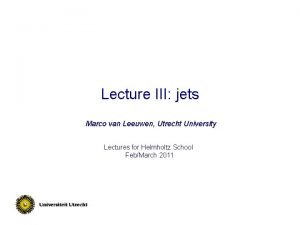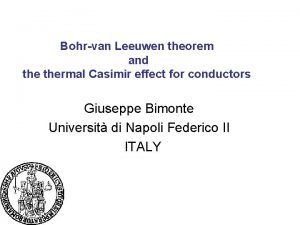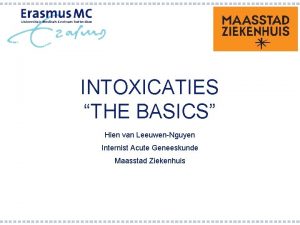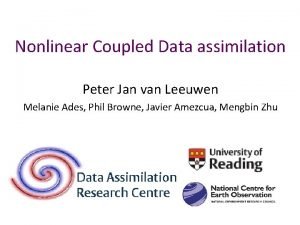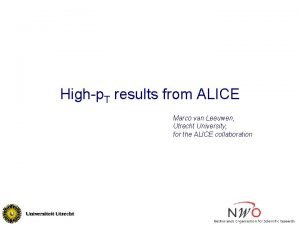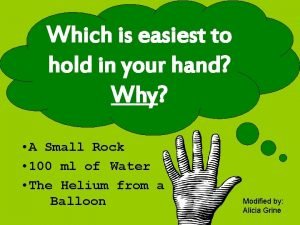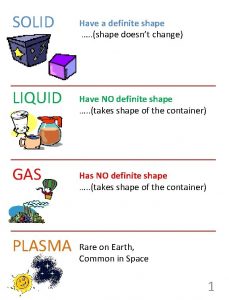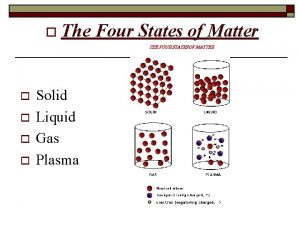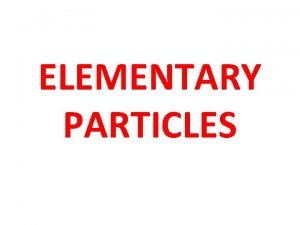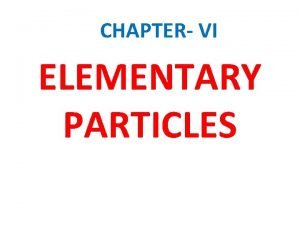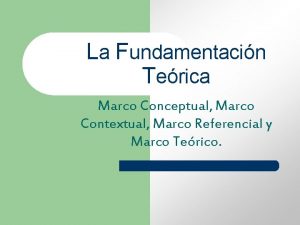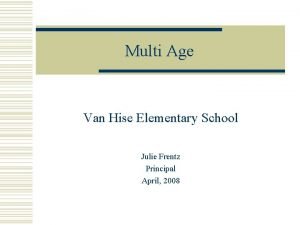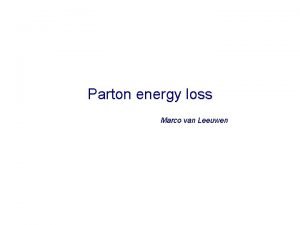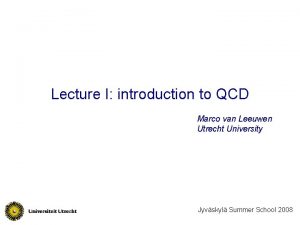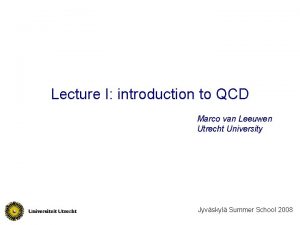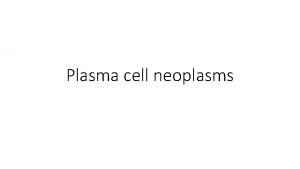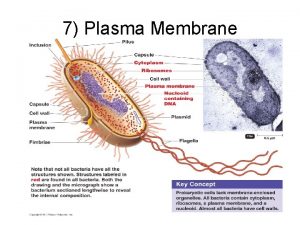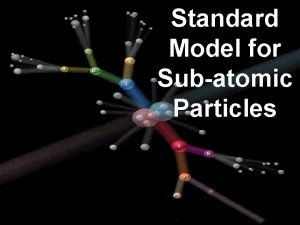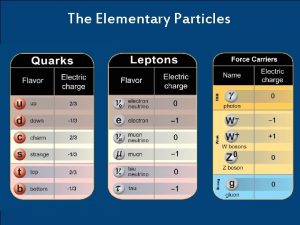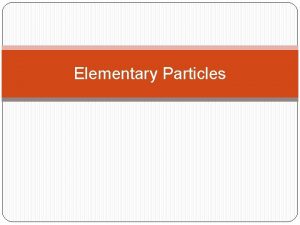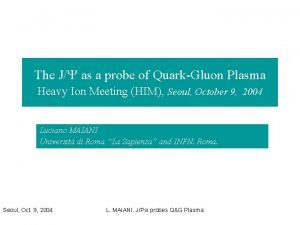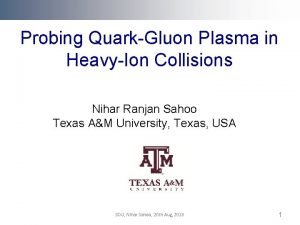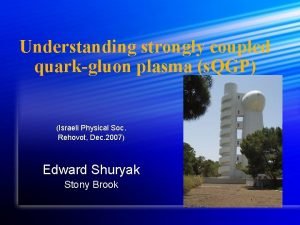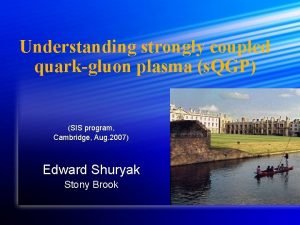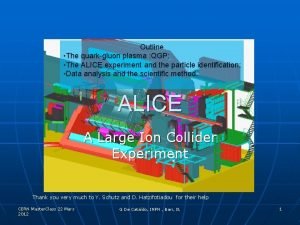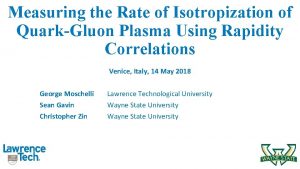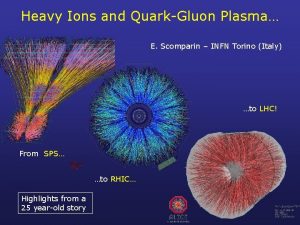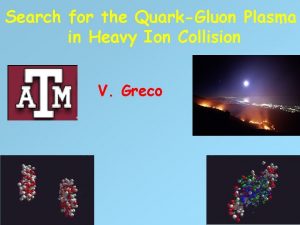The QuarkGluon Plasma Marco van Leeuwen Elementary particles

























- Slides: 25

The Quark-Gluon Plasma Marco van Leeuwen

Elementary particles Atom Electron elementary, point-particle Protons, neutrons Composite particle quarks Standard Model: elementary particles up charm top down strange bottom Leptons: Electrical charge electron Muon Tau ne nm nt Force carriers: photon EM force gluon strong force W, Z-boson weak force +anti-particles EM force binds electrons to nucleus in atom Strong force binds nucleons in nucleus and quarks in nucleons Quarks: Electrical charge Strong charge (color) 2

QCD and hadrons Quarks and gluons are the fundamental particles of QCD (feature in the Lagrangian) However, in nature, we observe hadrons: Color-neutral combinations of quarks, anti-quarks Baryon multiplet S strangeness Meson multiplet I 3 (u, d content) Baryons: 3 quarks I 3 (u, d content) Mesons: quark-anti-quark 3

Seeing quarks and gluons In high-energy collisions, observe traces of quarks, gluons (‘jets’) 4

How does it fit together? S. Bethke, J Phys G 26, R 27 Running coupling: as decreases with Q 2 Pole at m = L LQCD ~ 200 Me. V ~ 1 fm-1 Hadronic scale 5

Asymptotic freedom and p. QCD At large Q 2, hard processes: calculate ‘free parton scattering’ At high energies, quarks and gluons are manifest + more subprocesses 6

Low Q 2: confinement a large, perturbative techniques not suitable Bali, hep-lat/9311009 Lattice QCD: solve equations of motion (of the fields) on a space-time lattice by MC Lattice QCD potential String breaks, generate qq pair to reduce field energy 7

QCD matter Energy density from Lattice QCD g: deg of freedom Nuclear matter Quark Gluon Plasma Bernard et al. hep-lat/0610017 Tc ~ 170 -190 Me. V ec ~ 1 Ge. V/fm 3 Deconfinement transition: sharp rise of energy density at Tc Increase in degrees of freedom: hadrons (3 pions) -> quarks+gluons (37) 8

Quark Gluon Plasma (Quasi-)free quarks and gluons Critical Early universe Temperature QCD phase diagram Point Confined hadronic matter Elementary collisions (accelerator physics) High-density phases? Neutron stars Nuclear matter Bulk QCD matter: T and m. B drive phases 9

Heavy ion collisions Collide large nuclei at high energy to generate high energy density Quark Gluon Plasma Study properties RHIC: Au+Au s. NN = 200 Ge. V LHC: Pb+Pb √s. NN ≤ 5. 5 Te. V 27 km circumference Lac Leman Lake Geneva airport CERN Meyrin site 10

Nuclear geometry: Npart, Nbin, L, e b Npart: n. A + n. B (ex: 4 + 5 = 9 + …) Nbin: n. A x n. B (ex: 4 x 5 = 20 + …) Two limits: - Complete shadowing, each nucleon only interacts once, s Npart - No shadowing, each nucleon interact with all nucleons it encounters, s Nbin Soft processes: long timescale, large s, stot Npart Hard processes: short timescale, small s, stot Nbin Transverse view Density profile r: rpart or rcoll Eccentricity y L x Path length L, mean <L> 11

Centrality examples peripheral mid-central This is what you really measure. . . and this is what you see in a presentation 12

Centrality dependence of hard processes Total multiplicity: soft processes Binary collisions weight towards small impact parameter ds/d. Nch 200 Ge. V Au+Au Rule of thumb for A+A collisions (A>40) 40% of the hard cross section is contained in the 10% most central collisions 13

Selected topics in Heavy Ions • Elliptic flow – Bulk physics, low p. T, expansion driven by pressure gradients • Parton energy loss – High-energy parton ‘probes’ the quark gluon plasma – Light/heavy flavour 14

Collective Motion Only type of collective transverse motion in central collision (b=0) is radial flow. Integrates pressure history over complete expansion phase Elliptic flow, caused by anisotropic initial overlap region (b > 0) More weight towards early stage of expansion (the QGP phase) 15

Forming a system and thermalizing 1) Superposition of independent p+p: Animation: Mike Lisa momenta pointed at random relative to reaction plane b 16

Forming a system and thermalizing Animation: Mike Lisa 1) Superposition of independent p+p: high density / pressure at center momenta pointed at random relative to reaction plane 2) Evolution as a bulk system Pressure gradients (larger in-plane) push bulk “out” “flow” more, faster particles seen in-plane “zero” pressure in surrounding vacuum b 17

How does the system evolve? 1) Superposition of independent p+p: N momenta pointed at random relative to reaction plane 0 /4 /2 3 /4 - RP (rad) 2) Evolution as a bulk system Pressure gradients (larger in-plane) push bulk “out” “flow” more, faster particles seen in-plane N Animation: Mike Lisa - RP (rad) 18

Energy dependence of flow NA 49, PRC 68, 034903 • Flow at RHIC consistent with ideal hydrodynamics!! … so what will we get at LHC ? 19

Hard probes of QCD matter Use ‘quasi-free’ partons from hard scatterings Calculable with p. QCD to probe ‘quasi-thermal’ QCD matter Interactions between parton and medium: -Radiative energy loss -Collisional energy loss -Hadronisation: fragmentation and coalescence Quasi-thermal matter: dominated by soft (few 100 Me. V) partons Sensitive to medium density, transport properties 20

Energy loss in QCD matter radiated gluon QCD bremsstrahlung (+ LPM coherence effects) Transport coefficient m 2 propagating parton l Energy loss probes: Density of scattering centers: Nature of scattering centers, e. g. mass: radiative vs elastic loss Or no scattering centers, but fields synchrotron radiation? 21

0 RAA – high-p. T suppression : RAA = 1 0: RAA ≈ 0. 2 : no interactions RAA = 1 Hadrons: energy loss RAA < 1 Hard partons lose energy in the hot matter 22

1/Nbin d 2 N/d 2 p. T Two extreme scenarios Scenario I P( E) = d( E 0) ‘Energy loss’ Shifts spectrum to left Scenario II P( E) = a d(0) + b d(E) ‘Absorption’ p+p Downward shift Au+Au p. T P( E) encodes the full energy loss process Need multiple measurements to distentangle processes RAA gives limited information 23

RAA at LHC GLV BDMPS T. Renk, QM 2006 RHIC S. Wicks, W. Horowitz, QM 2006 LHC: typical parton energy > typical E Expected rise of RAA with p. T depends on energy loss formalism Nuclear modification factor RAA at LHC sensitive to radiation spectrum P( E) 24

Summary • Elementary particles of the strong interaction (QCD): quarks and gluon • Bound states: p, n, , K (hadrons) • Bulk matter: Quark-Gluon-Plasma – High T~200 Me. V • Heavy ion collisions: – Produce and study QGP – Elliptic flow – Parton energy loss 25
 Marco van leeuwen overleden
Marco van leeuwen overleden Bohr van leeuwen theorem
Bohr van leeuwen theorem Hien van leeuwen
Hien van leeuwen Flex college delft
Flex college delft Milou van leeuwen
Milou van leeuwen Peter jan van leeuwen
Peter jan van leeuwen Whdg2
Whdg2 Solid + heat =
Solid + heat = Plasma particles
Plasma particles Oo solid
Oo solid Basic particles
Basic particles Classification of elementary particles
Classification of elementary particles Fundamentacion contextual
Fundamentacion contextual Julie frentz
Julie frentz Hát kết hợp bộ gõ cơ thể
Hát kết hợp bộ gõ cơ thể Bổ thể
Bổ thể Tỉ lệ cơ thể trẻ em
Tỉ lệ cơ thể trẻ em Gấu đi như thế nào
Gấu đi như thế nào Glasgow thang điểm
Glasgow thang điểm Chúa sống lại
Chúa sống lại Kể tên các môn thể thao
Kể tên các môn thể thao Thế nào là hệ số cao nhất
Thế nào là hệ số cao nhất Các châu lục và đại dương trên thế giới
Các châu lục và đại dương trên thế giới Công của trọng lực
Công của trọng lực Trời xanh đây là của chúng ta thể thơ
Trời xanh đây là của chúng ta thể thơ
